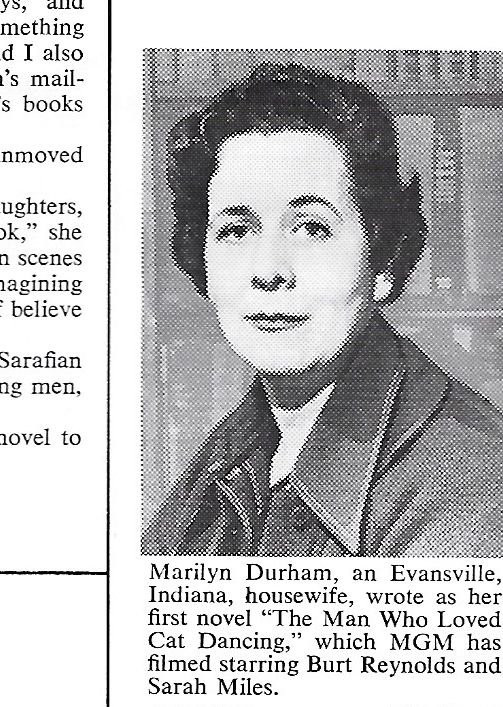I picked up “The Man Who Loved Cat Dancing” by Marilyn Durham with a mix of curiosity and skepticism. Learning that Durham was an alumna of my university, and notably, the only novelist listed among important alumni, piqued my interest. Despite this, my local library didn’t carry it, and I stumbled upon a vintage 1970s copy in a used bookstore—a find that felt both exciting and slightly obscure. The cover hinted at a bestseller, but its limited modern availability suggested it might not be a lasting classic. However, the mention of a Burt Reynolds movie adaptation gave me hope. And I must say, I was pleasantly surprised; I genuinely enjoyed this book.
The plot of “The Man Who Loved Cat Dancing” is nicely intricate, weaving a path that kept me engaged without being overly convoluted. It’s set in the Wyoming territory of the 1880s and plunges us into the life of Jay Grobart, a U.S. Army officer turned fugitive. He’s planning a daring train robbery and his life intersects with Catherine Crocker, a runaway wife seeking escape from her mundane marriage. Adding another layer is “Cat Dancing”, a captivating Native American woman and mother to Jay’s children, though she is not as central to the narrative as the title might suggest. This blend of characters and circumstances creates a compelling backdrop for a story of adventure and personal discovery.
Jay Grobart is a particularly well-crafted character. His motivations felt authentic, and his actions were consistent with his troubled persona. He embodies the kind of man who could easily capture a woman’s attention, only to reveal deeper, more complex layers beneath the surface. Catherine, on the other hand, presented a bit of a mixed bag for me. At times, she demonstrated remarkable strength, especially during the Native American attack, showcasing a resilience that was admirable. Yet, there were moments of perplexing weakness, such as her contradictory behavior around Jay, fluctuating between exhibitionism and shyness. Her swift and intense romantic feelings for Jay felt somewhat rushed and unconvincing. It seemed more like an infatuation with the novelty of Jay and the escape he represented, rather than deep-seated love.
Charlie emerged as my favorite supporting character. While Jay held my top spot for character engagement, Charlie’s quiet demeanor and sharp observational skills were incredibly appealing. His backstory with Jay was believable, depicting a deep-seated loyalty and friendship that was genuinely touching. Charlie’s consistent concern for Jay, highlighted by his visits, made him an admirable figure, and I wished his role had been more substantial within the narrative.
I found myself unexpectedly relating to Catherine, and it took some reflection to understand why. While I haven’t yearned to leave my relationship, I’ve certainly experienced periods of wanting to escape the confines of my town or job, dreaming of a spontaneous adventure. Catherine’s discontent with her current life and her longing for something new resonated with me. I believe this feeling of wanting a change, a break from routine, is a universal human experience, and it formed a significant part of my connection with Catherine’s character, even if her impulsive decisions were questionable.
The segments focusing on the group’s flight and their efforts to evade Lapchance were the most gripping parts of the book. Watching Jay seamlessly integrate Catherine into their escape plan and reading about their desert camping experiences was genuinely exciting. In contrast, the chapters detailing Lapchance and Willard’s pursuit felt less engaging. Their chase seemed drawn out and slow-paced, lacking the thrill and urgency that the main storyline maintained.
Catherine’s insistence on being in love with Jay felt somewhat forced. While I could accept a physical attraction developing between them, her persistent declarations of love felt exaggerated and weakened her character in my eyes. Had she acknowledged it as infatuation initially and then moved past it, it would have been more believable. Her prolonged insistence on it being love, however, felt unconvincing.
Jay’s internal conflict, his struggle to accept love, formed a crucial part of his character arc. He was visibly afraid when “Cat Dancing” loved him, and he initially resisted Catherine’s affections. His relentless pursuit of Johnny for years overshadowed his ability to consider life without his son. While his character development felt somewhat rushed towards the end, it was nonetheless a compelling journey. Catherine’s quest for independence, which I thought she established early in the novel by leaving Willard, became slightly muddled as the story progressed. It left me questioning what exactly she was truly seeking beyond immediate escape.
Writer’s Takeaway: “The Man Who Loved Cat Dancing” surprised me with its high-octane action, exceeding my initial expectations. Durham skillfully put her characters through considerable trials, enhancing the narrative’s depth. The book’s meticulous research into the 1880s Wyoming setting was evident and commendable. Despite being written in the 1970s by a Midwestern author, Durham authentically portrayed the era’s technology and atmosphere. As a fellow writer of historical fiction, I applaud Durham’s dedication to historical accuracy.
Overall, “The Man Who Loved Cat Dancing” is a highly enjoyable read, marred only by a minorly unconvincing romantic subplot. I rate it four out of five stars.
Until next time, write on.


